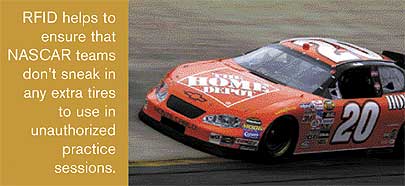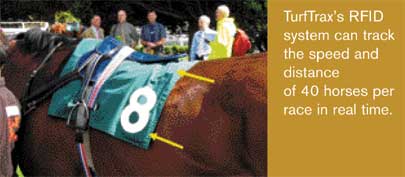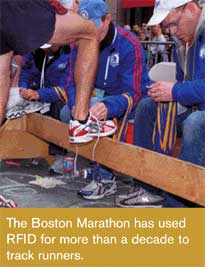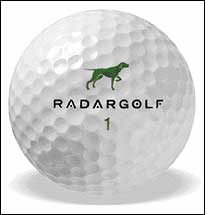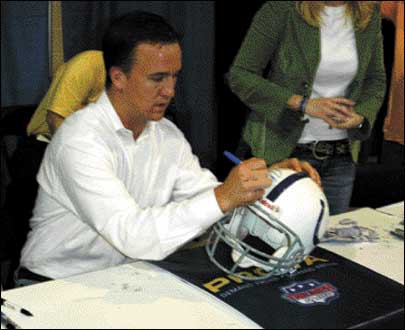Apr 01, 2008Timing is everything in sports—and not only on the track or playing field. Fans need to gain entry to their seats quickly and efficiently, and concession operators have to move their goods at a rapid pace. Most important, sports organizers and officials need to time competitors precisely and track split-second plays in events as diverse as NASCAR races, horse races and marathons.
Over the past several years, RFID has become an integral part of a growing number of sports and sports-related activities. RFID is even being incorporated into sports equipment to help golfers find their balls and memorabilia collectors authenticate their prized objects.
RFID is rapidly rising through the wide world of sports to become a major-league player, says Dan Mullen, president of AIM Global, a Warrendale, Pa.-based trade association representing automatic-identification solution providers. "The surface is just being scratched," he says. "The technology is well suited to support a number of different sports."
This August, the 2008 Olympics in Beijing will become the latest sporting event to use RFID technology for ticketing and security applications, as well as for various timing and scoring activities. In 2006, for example, the 3.5 million soccer fans who attended the FIFA World Cup games in Germany were issued tickets containing tags provided by Philips Semiconductors (now NXP).
Some 7 million Olympics tickets will incorporate RFID tags featuring a unique ID number, designed to make it impossible for the documents to be modified or counterfeited. By eliminating the need for manual identification, the technology also promises to accelerate ticket-holder entry into events while enabling officials to detect if a ticket is being reused. For added security, tickets to the opening and closing ceremonies will include the holder's digital picture and ID information. The tags will be produced by ASK-TongFang, a joint venture between France's ASK SA and China's Tsinghua Tongfang.
At a number of stadiums, including the Detroit Lions' Ford Field and the Philadelphia Eagles' Lincoln Financial Field, attendees can purchase food and souvenirs with the wave of an RFID-enabled key fob or wristband. Cashless payment systems reduce long lines at concession stands, boosting sales and ensuring that fans don't miss the action on the field.
From a fan's perspective, it may be hard to understand that brightly colored race cars, boldly emblazoned with sponsors' logos, are ever in need of any sort of identification. But racing organizations are keenly interested in using RFID to follow the positions of individual cars moving at breakneck speeds, often exceeding 220 miles per hour.
The Indy Racing League (IRL), the organization that officiates the annual Indianapolis 500, has been using RFID technology for race timing since 2004. Before last year's event, each vehicle was equipped with a TranX Pro transponder manufactured by AMB I.T. of Heemstede, Netherlands. The devices helped IRL officials track individual times, and data for each vehicle could be generated in real time throughout practice, testing and qualifying sessions, as well as during the race itself. System accuracy was maintained by mounting the transponder in a standardized position on each vehicle. TranX Pro technology is also used by 24 Hours of Le Mans, MotoGP, NASCAR, Porsche's Leipzig Testing Grounds, Shanghai International Circuit, Superbike World Championship and various other organizations.
In addition, NASCAR uses RFID to ensure full compliance with its strict tire regulations. The organization's rules require all racing teams to lease their tires from manufacturer and sponsor Goodyear Tire & Rubber, and to return them to the company immediately after leaving trials and races. This rule, which took effect in 2006, is designed to maintain competitive balance by ensuring that all teams roll on the same type of tires, use the same number of tires, and don't sneak in any extra tires to use in unauthorized practice sessions.
RFID stood alone as the best and most practical system for tracking the thousands of race tires used during each race and practice session, says Rick Heinrich, a product manager with Akron, Ohio-based Goodyear. "If there are multiple series running on a weekend, we can handle as many as 5,500 tires," he says. "Over the course of a season, it approaches 200,000."
Goodyear, a supplier to both Wal-Mart and the U.S. Department of Defense, already had several years of RFID experience. For the guts of its system, Goodyear turned to Advanced ID, based in Calgary, Alberta. The Canadian company, best known at the time for its pet-tagging technology, proposed a tire-tracking system based on UHF 915 MHz passive tags. But highly responsive chip technology wasn't all that Goodyear and NASCAR needed.
The biggest challenge Advanced ID and Goodyear faced when developing the system was whether the tags could withstand hellish racetrack environments that were known to obliterate chalk marks and bar codes within a matter of minutes. "The tires are subjected to a lot of punishment—heat, crashes, wall contact and so on," Heinrich says. The companies discovered that by burying the tags deeply inside the tires, they could safely withstand the longest races held under the most unforgiving conditions. "It's rare that they're not readable," Heinrich says. "Maybe in a severe crash or situation where there's severe tire damage."
The RFID system gives NASCAR officials the ability to identify each tire with a unique serial number, and to read incremental data such as tire size, total miles and wheel position. The racing league is now looking at tagging other racer components, such as wings and chassis. "The RFID system is flexible, it's efficient, it's accurate," Heinrich says. "It's a winner."
Besides speeding around an oval circuit, race cars and Thoroughbred horses don't have much in common. Well, actually, race car and horse owners may have at least one common bond: RFID technology.
Around the world, most horse races are still judged by officials using binoculars and photographic gear. "What's needed is something that's more accurate and less subjective to determine winners and positions," says Mark Kent, group managing director for TurfTrax Racing Data, a company that offers an RFID-based horse race tracking technology.
TurfTrax, based in Salisbury, England, has developed and patented a transportable RFID-based tracking system that enables the collection and broadcast of real-time speed and positional data on horses during the course of a race. The data is used by the horse racing, betting and media industries. TurfTrax investigated several tracking approaches before settling on RFID. "There were GPS tracking systems," says Kent, "but the problem with GPS is that it simply cannot meet the extremely high-availability and real-time needs in the racetrack environment."
The company turned to Sagentia Group, a Cambridge, England-based technology consulting and development firm, to design a proprietary RFID system that could track race horses in real time. In
creating the system, TurfTrax and Sagentia faced a number of challenges, including the need for a technology that could function effectively under punishing conditions and in a variety of physical settings.
The system, launched three years ago, has been commissioned for use on 14 out of 59 U.K. racetracks; TurfTrax also has rights agreements with horse-racing broadcaster Racing UK and racecourse owner/operator Arena Leisure Racing for access to 39 courses. The battery-powered 2.4 GHz active tag device, which is installed in the horse's saddle blanket, weighs a little less than 4 ounces and generates data up to seven times per second. The tag, which can run for as long as eight hours per charge, is reusable. The overall system can track as many as 40 horses per race. "From start to finish, you can tell where each horse is, how fast it's going and distance traveled," Kent says. "All of this granular information is available for each horse."
Kent describes U.K. racetracks as "the hardest market in the world to deal with." Beyond coping with rain, mud and a wide temperature range, the system infrastructure needs to accommodate different track layouts. "The majority of U.S. courses are very standard," Kent says. "In the U.K., there are 59 racetracks and they are all completely different shapes and dimensions."
Using RFID and wireless networking, TurfTrax and Sagentia were able to meet the design challenge with a mobile radio–based environment that can rapidly be deployed to accommodate any track layout, and to cope with all sorts of weather conditions. The approach also eliminated the expense and disruption of burying cables or installing permanently fixed readers. The number of readers used ranges from 20 to 60 units, depending on the track's size and configuration. "As long as the chip is seen by a minimum of three receivers, it's simple enough to triangulate it and calculate the difference of when the signals are received," Kent says. "This pinpoints where the horse is at any point in time. A wireless backhaul sends data collected by the portable readers to a central processing point."
With RFID already widely used at U.K. tracks, TurfTrax is now looking for new customers worldwide, Kent says. The company is currently talking with racing, media and betting authorities in Australia, Cyprus, France, Hong Kong, Italy, New Zealand and Sweden. TurfTrax has already exported its technology to Japan. "Anywhere horses run," Kent says, "they can run with better metrics."
Two-legged racers also are falling into step with RFID. In fact, marathon organizers and officials have been RFID pioneers: The Boston Marathon has used RFID for more than a decade, says Marc Chalufour, a spokesperson for the Boston Athletic Association (BAA), the event's organizer. The turning point came in 1996, when the race's field was expanded from about 10,000 runners to nearly 40,000. "We decided we needed a more efficient way to keep track of everyone," Chalufour says.
For a solution, the BAA turned to technology developed by ChampionChip, a company based in Nijmegan, Netherlands, that manufactures RFID sports systems. The ChampionChip transponder is a waterproof plastic capsule that contains an RFID chip and an energizing coil. The transponder, a small token that's tied onto the runner's shoelaces, can be used under all weather conditions—wet and dry, hot and cold. "We've used it every year since 1996," Chalufour says.
The technology allows the BAA to identify specific marathoners at the start and finish lines, track their time and position, and issue red flags for missed checkpoints. The system also provides continuously updated information to the media throughout the race. "Chip mats," which are rubber-covered reader antennas, are deployed at 5-kilometer intervals throughout the course. "We can tell who is running, their position and their pace," Chalufour says. "This is very valuable information that we had no way of obtaining before."
While RFID has allowed the BAA to gain tighter control over runners and more detailed event results, the decade-old system has its drawbacks, including relatively low read speeds and a token that must be collected from the runner after the race (occasionally a few fall off somewhere en route). Racetimer, a company in Norrköping, Sweden, that specializes in race timing and measurement systems, believes it can take race tracking to a new level by using Gen 2 UHF technology. Working with Morgan Hill, Calif.-based RFID systems vendor Alien Technology, Racetimer has developed a next-generation RFID race monitoring system that promises to fix many of the shortcomings of current systems while adding several new capabilities.
Racetimer product marketing director Khaled Azerkan says that higher-frequency Gen 2 tags provide faster read times and allow the use of lightweight transponders that can be securely attached to a runner's identification bib. "By using UHF, we can use low-cost tags, which means we don't have to collect them after the race," Azerkan says. "This saves money, effort and time, not only for the organizers and timers but also for the runners."
Thanks to the chest-level bib-mounted tags, the Racetimer system eliminates the need for mats, says Ronny Haraldsvik, Alien's vice president of marketing and industry relations. "The technology also allows organizers to associate racers with checkpoints, providing two potential additional revenue sources—selling photos of runners taken during the race, and sending text alerts of runners' progress to friends and family."
Alien and Racetimer faced several challenges in applying Gen 2 technology to racing. The biggest roadblock was overcoming UHF signals' resistance to passing through water. "A human being is composed of 70 percent water," Azerkan notes. Therefore, marathoners trapped inside a group of runners could be easily missed by UHF systems. Highly sensitive and better-positioned readers helped solved this problem. Racetimer's system misses only 0.4 percent of reads, according to Azerkan, "and in these cases it's often the runner himself who has caused the problem by making some mistake, like forgetting to put on the bib," he says. In 2008, the company will have systems in Belgium, France, Holland, Scandinavia and Switzerland. "Our goal is to become the biggest timing company in the world by 2011," Azerkan says.
Another vendor with an RFID runner tracking system is IPICO Sports, based in Peoria, Ill. IPICO's timing system combines two technologies: IPICO IP-X dual-frequency passive tags and the IP-X RFID air interface. The company says the tags are energized at 125 kHz, allowing a long-range charge-up, and they backscatter their IDs at 6.8 MHz, enabling fast read rates. IP-X is an anti-collision protocol that allows high volumes of tags to be read simultaneously. IPICO's technology has been used by running organizations in Peoria; Boulder, Colo.; and Mexico City.
As RFID tags get smaller and cheaper, many observers expect an explosion in sports applications. The day may not be far off when RFID becomes an integral part of virtually all sports gear—shoes, gloves, bats, skis and ski poles, golf clubs, goalposts, nets, bases and more—allowing officials to make unerring calls, and players and fans to receive a steady, virtually unending stream of performance information. "We're talking about an entirely new ball game," says AIM Global's Mullen.
Par for the Course
If time is one of the reasons fewer people in the United States are playing golf these days, RadarGolf could help get the game back on course. Radar Corp., based in San Ramon, Calif., has devised a way to build RFID tags into golf balls to make them easier to find. "It's kind of funny to have grown men wandering back and forth looking for a little white ball," says Chris Savarese, Radar Corp.'s founder and president.
The RadarGolf system differs from most other RFID systems in that the technology's goal is to help users find a lost object rather than to track something like a shipping case or pallet. A dual-frequency (915/1,830 MHz) passive tag is embedded in the ball, and a handheld reader gives the golfer aural and visual feedback, via an audio tone and LCD, as he or she approaches a missing ball.
The golf ball meets all United States Golf Association specifications for size, weight, distance, initial velocity and symmetry, Savarese says. The trickiest part of the development, he notes, was devising a ball that could be repeatedly whacked without losing its shape, flight characteristics, physical integrity or RFID functionality. To achieve this goal, as well as to simplify production, the ball is tagged snuggly in its core at the time of manufacture. "It tests well against all the balls in the market that don't have a tag in them," Savarese says.
These days, Savarese is spending his time trying to get the attention of the sport's top manufacturers, including Callaway, Nike and Titleist. "We've always had plans to license the technology to a big, established brand," he says. A next-generation RadarGolf ball, currently in the works, will feature a wider detection range and a smaller handheld reader. It will also be marketed under a well-known golf ball brand, Savarese says. For now, RadarGolf is available on the company's Web site. A starter kit, consisting of a dozen balls, a handheld reader, a carrying case and accessories, is priced at $199.95.
Getting Real
Thousands of fans who attend the Football Spectacular collectibles conventions that are held across the country each year can now get an RFID pedigree of their sports memorabilia, helping to shore up an industry that has long been vulnerable to fraud. Prova Group's Autograph Certification System authenticates signed objects, ranging from photographs to balls and helmets.
Irving, Texas-based Prova's RFID system includes an adhesive tag with a 13.56 MHz passive chip that's affixed to the item before it's signed. The tag is activated at the registration desk, and its unique ID, as well as the collector's name and address, is entered into the Prova Online Registry. At the signing, the autographer's secure ID code—which includes when and where the signing took place—is written to the tag and linked to the entry in the online database.
The tag can be updated by Prova to verify any other signature that's added to the item at a later date. "When an item appears in the Prova Online Registry," says Prova spokesperson Cindy Vandament, "you can be certain it's the real thing."

